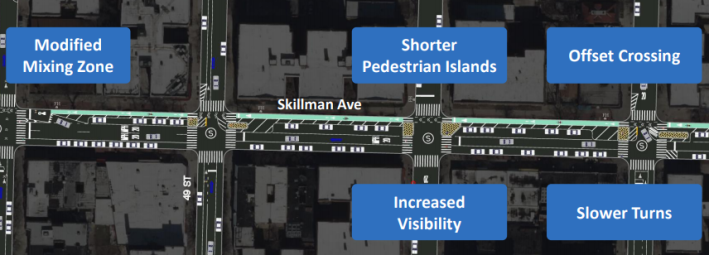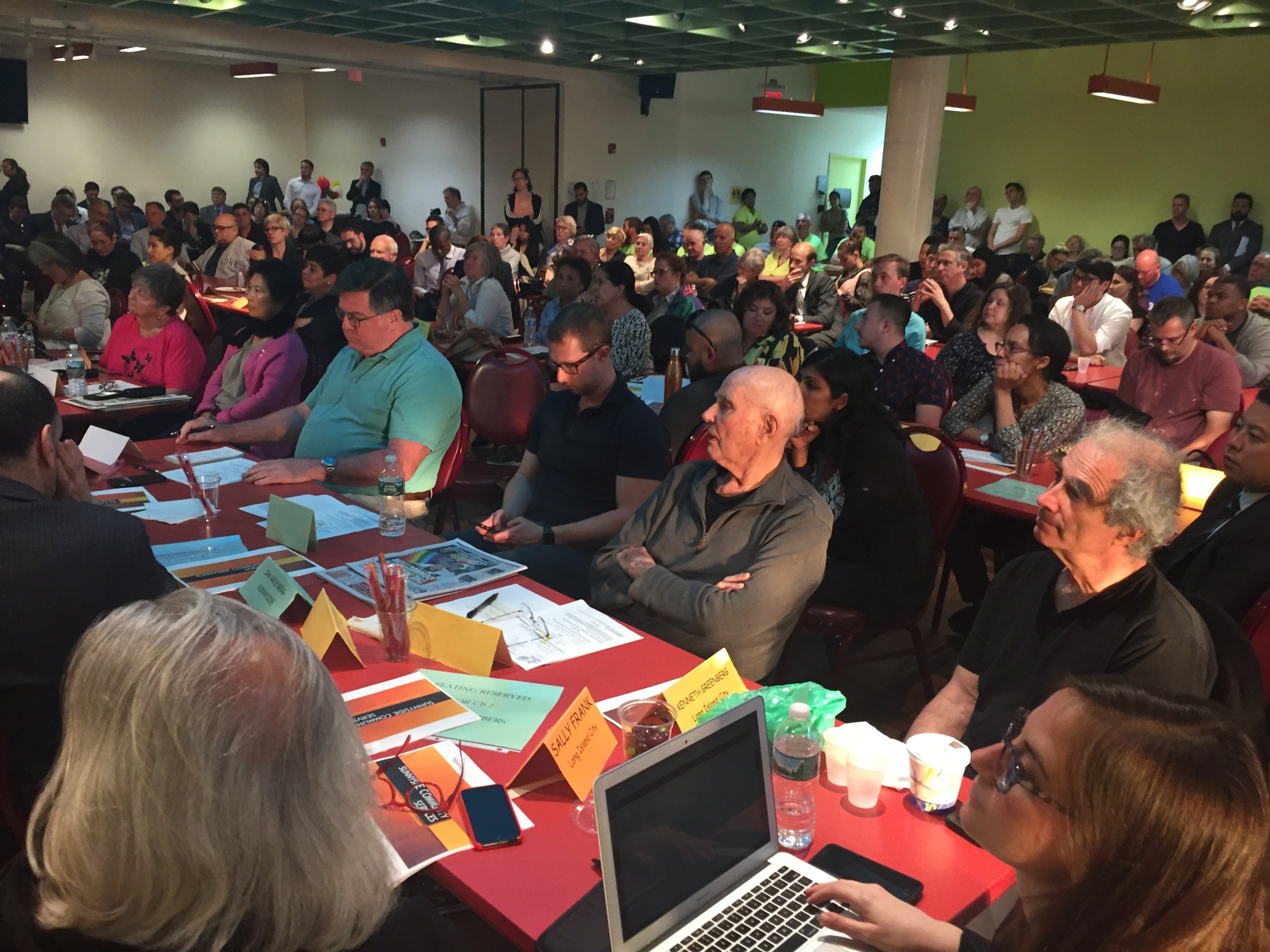Imagine for a moment that scientists invent a medicine that reliably reduces mortality with no longterm side effects, but before administering it, public officials seek permission from New York City community boards. And the community boards often vote not to use it.
That's basically what New York does with protected bike lanes. Last night's meeting of Queens Community Board 2, which voted 27-8 against protected bike lanes and pedestrian safety improvements on Skillman Avenue and 43rd Avenue in Sunnyside, was one of the more ridiculous recent examples of how this process can devolve into farce.
Despite the ample empirical data proving that New York's protected bike lanes have reduced traffic injuries and the absence of any evidence that they harm retail businesses, the testimony last night was rife with assertions that seniors and children will get hurt and merchants will suffer.
P.S. 150 PTA co-president Diana Dumitru told the board, "We are opposed [to] this bike lane because of safety issues. This bike lane would be better... on other streets, and not on a street that crosses two elementary schools that serve 2,400 kids."
But in fact the students at those schools will be exposed to greater risk of traffic injuries without the redesign -- before-and-after data from dozens of protected bike lane projects in the city has proven as much. The entire impetus for the project is public safety, and the desire to prevent crashes that claimed the life of Gelacio Reyes and severely injured David Nunes last year.
The project would flip the existing bike lanes and parking lanes on Skillman and 43rd, installing pedestrian islands at some intersections and removing a car lane on less-trafficked blocks to deter speeding [PDF].
DOT made adjustments to the plan to appease business owners worried about repurposing parking spaces, cutting the net reduction in parking to 116 spaces -- including 13 metered spots. Averaged across 2.6 miles of streets, it's a trivial adjustment to the parking supply, for a project that promises to improve access for people walking or biking.

That had no bearing on the opinion of Aubergine Cafe owner Gary O'Neill, a ringleader of the businesses opposed to the project. O'Neill refused to accept studies of retail sales from other protected bike lane projects in New York showing no adverse impact. "They keep bringing up examples that have nothing to do with these streets, not just Skillman and 43rd Avenue, but anywhere in Queens," he said.
It was an atmosphere of hysteria that U.S. Representative Joe Crowley and local Council Member Jimmy Van Bramer have indulged. Crowley, the powerful head of the Queens Democratic Party, came out against the proposal on the basis that the "community" opposed it. But plenty of local residents spoke out in favor last night.
"DOT has come up with a plan that's based on their experience elsewhere and their toolkit, mostly, of proven methods to resolve the issues," said Matt McElroy, who lives on 43rd Avenue in Elmhurst. "They're trying to save lives. They're trying to save our kids' lives, our grandparents' lives."
"I'm very aware of the challenges to find parking in recent years," said Woodside resident Katie Reilly, who told the board she supported the redesign. "I go down Skillman and 43rd every day, and it is dangerous."
Van Bramer, meanwhile, had called on DOT to install a protected bike lane on 43rd Avenue after Reyes was killed, but then refused to endorse the project. Instead, he let a repetitive procession of town halls, workshops, and community board meetings delay action, citing "grave concerns from business owners" upset about repurposing what amounts to a couple of parking spots per block.
Van Bramer chief of staff Matthew Wallace told attendees at last night's meeting that the council member could not attend because he was tied up in budget negotiations. Wallace declined to comment after the board's vote.
DOT can still move forward with the redesign without the board's approval -- that's what the de Blasio administration is doing with a segment of Queens Boulevard in Forest Hills this year.
As former NYC DOT policy director Jon Orcutt said on Twitter, the community board process could be restructured to incorporate productive feedback and sift out the fearmongering, instead of serving as a de facto veto point for necessary public safety improvements.
In a statement, DOT said it will "review our options":
The design that was presented last night articulated our responsiveness to the top concern, which was parking loss. Over the past few months, DOT reworked the design to preserve as many parking spaces as possible, and in some instances, including in the commercial core, with no parking loss on the south curb of Skillman Ave and north curb of 43rd Avenue, respectively.
DOT always appreciates community board feedback , but considers the vote to be advisory on substantive safety projects. We will review our options for moving forward and continue the dialogue with the Board and other local stakeholders about making these streets safer for the local community and all Queens residents who use these corridors to shop and commute.






